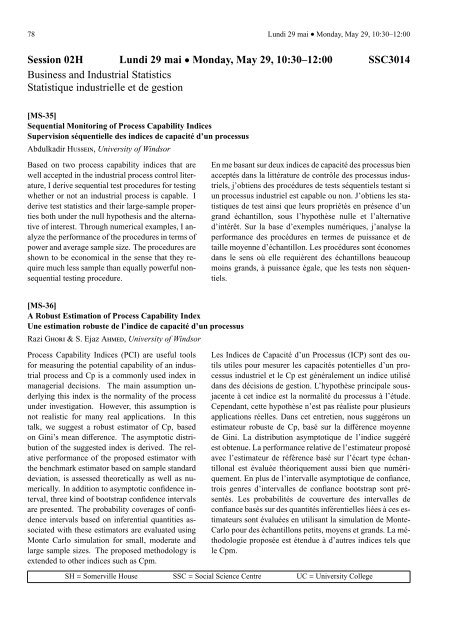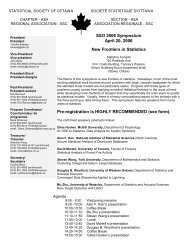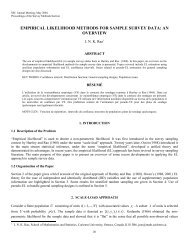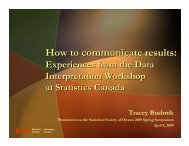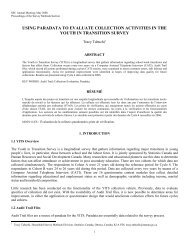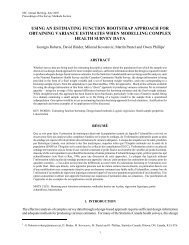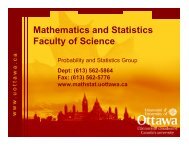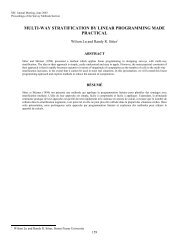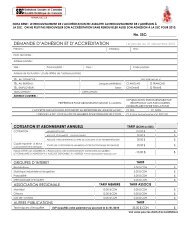78 Lundi 29 mai • Monday, May 29, 10:30–12:00Session 02H Lundi 29 mai • Monday, May 29, 10:30–12:00 SSC3014Business and In<strong>du</strong>strial StatisticsStatistique in<strong>du</strong>strielle <strong>et</strong> de gestion[MS-35]Sequential Monitoring of Process Capability IndicesSupervision séquentielle des indices de capacité d’un processusAb<strong>du</strong>lkadir HUSSEIN, University of WindsorBased on two process capability indices that arewell accepted in the in<strong>du</strong>strial process control literature,I derive sequential test proce<strong>du</strong>res for testingwh<strong>et</strong>her or not an in<strong>du</strong>strial process is capable. Iderive test statistics and their large-sample propertiesboth under the null hypothesis and the alternativeof interest. Through numerical examples, I analyz<strong>et</strong>he performance of the proce<strong>du</strong>res in terms ofpower and average sample size. The proce<strong>du</strong>res areshown to be economical in the sense that they requiremuch less sample than equally powerful nonsequentialtesting proce<strong>du</strong>re.En me basant sur deux indices de capacité des processus bienacceptés dans la littérature de contrôle des processus in<strong>du</strong>s-triels, j’obtiens des procé<strong>du</strong>res de tests séquentiels testant siun processus in<strong>du</strong>striel est capable ou non. J’obtiens les sta-tistiques de test ainsi que leurs propriétés en présence d’ungrand échantillon, sous l’hypothèse nulle <strong>et</strong> l’alternatived’intérêt. Sur la base d’exemples numériques, j’analyse laperformance des procé<strong>du</strong>res en termes de puissance <strong>et</strong> d<strong>et</strong>aille moyenne d’échantillon. Les procé<strong>du</strong>res sont économesdans le sens où elle requièrent des échantillons beaucoupmoins grands, à puissance égale, que les tests non séquen-tiels.[MS-36]A Robust Estimation of Process Capability IndexUne estimation robuste de l’indice de capacité d’un processusRazi GHORI & S. Ejaz AHMED, University of WindsorProcess Capability Indices (PCI) are useful toolsfor measuring the potential capability of an in<strong>du</strong>s-Les Indices de Capacité d’un Processus (ICP) sont des outilsutiles pour mesurer les capacités potentielles d’un protrialprocess and Cp is a commonly used index in cessus in<strong>du</strong>striel <strong>et</strong> le Cp est généralement un indice utilisémanagerial decisions. The main assumption un- dans des décisions de gestion. L’hypothèse principale sousderlyingthis index is the normality of the process jacente à c<strong>et</strong> indice est la normalité <strong>du</strong> processus à l’étude.under investigation. However, this assumption is Cependant, c<strong>et</strong>te hypothèse n’est pas réaliste pour plusieursnot realistic for many real applications. In this applications réelles. Dans c<strong>et</strong> entr<strong>et</strong>ien, nous suggérons untalk, we suggest a robust estimator of Cp, based estimateur robuste de Cp, basé sur la différence moyenneon Gini’s mean difference. The asymptotic distri- de Gini. La distribution asymptotique de l’indice suggérébution of the suggested index is derived. The rel- est obtenue. La performance relative de l’estimateur proposéative performance of the proposed estimator with avec l’estimateur de référence basé sur l’écart type échanthebenchmark estimator based on sample standard tillonal est évaluée théoriquement aussi bien que numérideviation,is assessed theor<strong>et</strong>ically as well as nu- quement. En plus de l’intervalle asymptotique de confiance,merically. In addition to asymptotic confidence in- trois genres d’intervalles de confiance bootstrap sont préterval,three kind of bootstrap confidence intervals sentés. Les probabilités de couverture des intervalles deare presented. The probability coverages of confi- confiance basés sur des quantités inférentielles liées à ces esdenceintervals based on inferential quantities as- timateurs sont évaluées en utilisant la simulation de Montesociatedwith these estimators are evaluated using Carlo pour des échantillons p<strong>et</strong>its, moyens <strong>et</strong> grands. La mé-Monte Carlo simulation for small, moderate and thodologie proposée est éten<strong>du</strong>e à d’autres indices tels quelarge sample sizes. The proposed m<strong>et</strong>hodology is le Cpm.extended to other indices such as Cpm.SH = Somerville House SSC = Social Science Centre UC = University College
Lundi 29 mai • Monday, May 29, 10:30–12:00 79[MS-37]Special Mixture Discriminant Model for Drug Discovery DataModèle de mélange discriminant en recherche de médicamentsXu Sunny WANG, University of Waterloo, Hugh CHIPMAN, Acadia University, William J. WELCH, University ofBritish ColumbiaIn drug discovery, statistical models have played avery important role for predicting activity of com-En recherche de médicaments, les modèles <strong>statistique</strong>s ontjoué un rôle important dans la prédiction de l’activité depounds against biological targ<strong>et</strong>s. In this super- composés contre différentes cibles biologiques. Dans ce provisedlearning problem, descriptors of molecular blème d’apprentissage supervisé, des descripteurs de strucstructure(e.g. atomic weight, types of bonds, many ture moléculaire (par exemple : poids atomique, types deother exotic characteristics) are used to predict ac- liens, plusieurs autres caractéristiques exotiques) sont utilitivity.Compounds often cluster in the descriptor sés pour prédire l’activité. Les composés se regroupent souspace,making mixture discriminant analysis a nat- vent dans l’espace descripteur, faisant de l’analyse discrimiuralsupervised learning tool. Conventional mix- nante de mélange un outil naturel d’apprentissage supervisé.ture discriminant m<strong>et</strong>hods have difficulty finding Les méthodes de mélange discriminant conventionnelles ontthe best model for the drug discovery data. Com- de la difficulté à trouver le meilleur modèle pour des donnéesplex structure and high dimensionality lead to over de recherche de médicaments. Des structures complexes <strong>et</strong>param<strong>et</strong>erized models. It is believed that the bi- une haute dimensionnalité amènent des modèles surparaologicalactivity of compounds only depends on métrisés. Une supposition courante est que l’activité bioloseveraldescriptors, so we intro<strong>du</strong>ce a special mix- gique des composés ne dépend que de quelques descripteurs.ture model, which has fewer param<strong>et</strong>ers, and seeks Nous intro<strong>du</strong>isons donc un modèle de mélange spécial, ayantto predict using multiple subspaces (i.e., multi- moins de paramètres <strong>et</strong> cherchant à prédire en utilisant deple mechanisms). A constrained EM algorithm is multiples sous-espaces (c.-à-d. de multiples mécanismes).used to estimate param<strong>et</strong>ers, in conjunction with Un algorithme EM avec contraintes est utilisé pour estimercarefully chosen initial values and some other tun- les paramètres. Les valeurs initiales <strong>et</strong> quelques autres paraingparam<strong>et</strong>ers. We present results using both a mètres d’ajustement sont choisis soigneusement. Nous préfirst-ordermodel that captures “main effect” and a sentons des résultats utilisant un modèle de premier ordre quisecond-order model capable of identifying interac- identifie « l’eff<strong>et</strong> principal » <strong>et</strong> un modèle de second ordr<strong>et</strong>ive effects b<strong>et</strong>ween pairs of descriptors.capable d’identifier des eff<strong>et</strong>s interactifs entre les paires dedescripteurs.[MS-38]Risk-re<strong>du</strong>cing Stein-like Estimation in a Lif<strong>et</strong>ime Censored Regression ModelEstimation de Stein ré<strong>du</strong>isant le risque dans un modèle de régression pour le temps de survie censuréShakhwat HOSSAIN & S. Ejaz AHMED, University of WindsorNous considérons le problème de l’estimation d’un paramètre(vectoriel) de régression dans un modèle de régres-sion de Weibull avec censure où nous suspectons que lesparamètres peuvent être restreints à un sous-espace linéaire.Sous c<strong>et</strong>te incertitude, nous présentons une base pour combi-ner de façon optimale les problèmes d’estimation. L’objectifest de fournir des estimateurs adaptatifs naturels libres dechoix subjectifs. Dans le contexte de deux modèles de ré-gression de Weibull en compétition (compl<strong>et</strong> <strong>et</strong> restreint),nous démontrons un estimateur de type Stein qui, asympto-tiquement, performe mieux que l’estimateur <strong>du</strong> maximumde vraisemblance classique. Une étude par simulation deMonte-Carlo est aussi effectuée afin d’évaluer la perfor-The problem of estimation of a regression param<strong>et</strong>er(vector) in a Weibull regression model withcensoring is considered when it is suspected thatparam<strong>et</strong>ers may be restricted to a linear subspace.Under this uncertainty, we present a basis for optimallycombining estimation problems. The objectiveis to provide natural adaptive estimators thatare free of subjective choices. In the context of twocomp<strong>et</strong>ing Weibull regression models (full and re<strong>du</strong>ced),we demonstrate a Stein-type estimator, thatoutperforms the classical maximum likelihood estimatorasymptotically. A Monte Carlo simulationstudy is also con<strong>du</strong>cted to assess the performanceSH = Somerville House SSC = Social Science Centre UC = University College
- Page 1 and 2:
3Table of Contents • Table des ma
- Page 3 and 4:
Welcome • Bienvenue 5détails sur
- Page 5 and 6:
7Organizers • OrganisateursLocal
- Page 7 and 8:
General Information • Information
- Page 9 and 10:
General Information • Information
- Page 12 and 13:
14 Committees and Meetings • Comi
- Page 14 and 15:
16 Committees and Meetings • Comi
- Page 16 and 17:
18 List of Sessions • Liste des s
- Page 18 and 19:
20 List of Sessions • Liste des s
- Page 20 and 21:
22 List of Sessions • Liste des s
- Page 22 and 23:
24 Dimanche 28 mai • Sunday, May
- Page 24 and 25:
26 Lundi 29 mai • Monday, May 29,
- Page 26 and 27: 28 Lundi 29 mai • Monday, May 29,
- Page 28 and 29: 30 Lundi 29 mai • Monday, May 29,
- Page 30 and 31: 32 Lundi 29 mai • Monday, May 29,
- Page 32 and 33: 34 Lundi 29 mai • Monday, May 29,
- Page 35 and 36: Mardi 30 mai • Tuesday, May 30, 1
- Page 37 and 38: Mardi 30 mai • Tuesday, May 30, 1
- Page 39 and 40: Mardi 30 mai • Tuesday, May 30, 1
- Page 41 and 42: Mardi 30 mai • Tuesday, May 30, 1
- Page 43 and 44: Mardi 30 mai • Tuesday, May 30, 1
- Page 45 and 46: Mardi 30 mai • Tuesday, May 30, 1
- Page 47 and 48: Mardi 30 mai • Tuesday, May 30, 1
- Page 49 and 50: Mercredi 31 mai • Wednesday, May
- Page 51 and 52: Mercredi 31 mai • Wednesday, May
- Page 53 and 54: Mercredi 31 mai • Wednesday, May
- Page 55 and 56: Mercredi 31 mai • Wednesday, May
- Page 57 and 58: Mercredi 31 mai • Wednesday, May
- Page 59 and 60: 61Abstracts • RésumésSession 0
- Page 61 and 62: Dimanche 28 mai • Sunday, May 28,
- Page 63 and 64: Lundi 29 mai • Monday, May 29, 08
- Page 65 and 66: Lundi 29 mai • Monday, May 29, 10
- Page 67 and 68: Lundi 29 mai • Monday, May 29, 10
- Page 69 and 70: Lundi 29 mai • Monday, May 29, 10
- Page 71 and 72: Lundi 29 mai • Monday, May 29, 10
- Page 73 and 74: Lundi 29 mai • Monday, May 29, 10
- Page 75: Lundi 29 mai • Monday, May 29, 10
- Page 79 and 80: Lundi 29 mai • Monday, May 29, 10
- Page 81 and 82: Lundi 29 mai • Monday, May 29, 13
- Page 83 and 84: Lundi 29 mai • Monday, May 29, 13
- Page 85 and 86: Lundi 29 mai • Monday, May 29, 15
- Page 87 and 88: Lundi 29 mai • Monday, May 29, 15
- Page 89 and 90: Lundi 29 mai • Monday, May 29, 15
- Page 91 and 92: Lundi 29 mai • Monday, May 29, 15
- Page 93 and 94: Lundi 29 mai • Monday, May 29, 15
- Page 95 and 96: Lundi 29 mai • Monday, May 29, 15
- Page 97 and 98: Lundi 29 mai • Monday, May 29, 15
- Page 99 and 100: Mardi 30 mai • Tuesday, May 30, 0
- Page 101 and 102: Mardi 30 mai • Tuesday, May 30, 1
- Page 103 and 104: Mardi 30 mai • Tuesday, May 30, 1
- Page 105 and 106: Mardi 30 mai • Tuesday, May 30, 1
- Page 107 and 108: Mardi 30 mai • Tuesday, May 30, 1
- Page 109 and 110: Mardi 30 mai • Tuesday, May 30, 1
- Page 111 and 112: Mardi 30 mai • Tuesday, May 30, 1
- Page 113 and 114: Mardi 30 mai • Tuesday, May 30, 1
- Page 115 and 116: Mardi 30 mai • Tuesday, May 30, 1
- Page 117 and 118: Mardi 30 mai • Tuesday, May 30, 1
- Page 119 and 120: Mardi 30 mai • Tuesday, May 30, 1
- Page 121 and 122: Mardi 30 mai • Tuesday, May 30, 1
- Page 123 and 124: Mardi 30 mai • Tuesday, May 30, 1
- Page 125 and 126: Mardi 30 mai • Tuesday, May 30, 1
- Page 127 and 128:
Mardi 30 mai • Tuesday, May 30, 1
- Page 129 and 130:
Mardi 30 mai • Tuesday, May 30, 1
- Page 131 and 132:
Mardi 30 mai • Tuesday, May 30, 1
- Page 133 and 134:
Mardi 30 mai • Tuesday, May 30, 1
- Page 135 and 136:
Mardi 30 mai • Tuesday, May 30, 1
- Page 137 and 138:
Mardi 30 mai • Tuesday, May 30, 1
- Page 139 and 140:
Mardi 30 mai • Tuesday, May 30, 1
- Page 141 and 142:
Mardi 30 mai • Tuesday, May 30, 1
- Page 143 and 144:
Mercredi 31 mai • Wednesday, May
- Page 145 and 146:
Mercredi 31 mai • Wednesday, May
- Page 147 and 148:
Mercredi 31 mai • Wednesday, May
- Page 149 and 150:
Mercredi 31 mai • Wednesday, May
- Page 151 and 152:
Mercredi 31 mai • Wednesday, May
- Page 153 and 154:
Mercredi 31 mai • Wednesday, May
- Page 155 and 156:
Mercredi 31 mai • Wednesday, May
- Page 157 and 158:
Mercredi 31 mai • Wednesday, May
- Page 159 and 160:
Mercredi 31 mai • Wednesday, May
- Page 161 and 162:
Mercredi 31 mai • Wednesday, May
- Page 163 and 164:
Mercredi 31 mai • Wednesday, May
- Page 165 and 166:
Mercredi 31 mai • Wednesday, May
- Page 167 and 168:
Mercredi 31 mai • Wednesday, May
- Page 169 and 170:
Mercredi 31 mai • Wednesday, May
- Page 171 and 172:
Mercredi 31 mai • Wednesday, May
- Page 173 and 174:
Mercredi 31 mai • Wednesday, May
- Page 175 and 176:
Mercredi 31 mai • Wednesday, May
- Page 177 and 178:
179Author Index • Index des auteu
- Page 179 and 180:
Author Index • Index des auteurs
- Page 181 and 182:
Author Index • Index des auteurs
- Page 183 and 184:
Author Index (per session) • Inde
- Page 185 and 186:
Author Index (per session) • Inde
- Page 187:
Author Index (per session) • Inde


